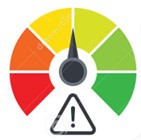Source: Erik Schriemer, investment expert at MeDirect
You can make money when investing. Of course, you hope for a high return when you start, but it is good to know that the higher your desired return is, the higher the risk is that you may have to take. The return and the risk are strongly linked.
In this article we would like to tell you more about how this ratio works and what the most important points of attention are when determining your risk/return ratio. We think it is important that no matter how you invest, you do this in a way that suits you. Your money your way.
What is return?
Simply put, return is the profit that has been made from an investment. This seems clear but calculating your return can sometimes still be quite complex. What often makes the calculation complicated are the interim additional deposits and withdrawals. Through our app and website, you always have a good insight into your actual return, calculated in the right way.
If the value of your investments is higher than your initial deposits, you have made a profit. If this is lower, you have made a loss. But how does this relate to the risk? Have you taken a lot of risk to achieve that return?
What is risk?
As a rule, the higher the (desired) return, the higher the risk you may have to take for this. If you were to list the most popular investment products from low return/low risk to high return/high risk, it would usually look like this:
- Savings account
- Government bonds
- Corporate bonds
- Mutual funds and ETFs
- Individual stocks
- Complex financial products such as options and futures (MeDirect has chosen not to offer these products)

What is a realistic return?
You’ve probably heard a fantastic story from someone who has made a sky-high return. This of course sounds very interesting, but is this realistic? As mentioned, return and risk are strongly linked. With these types of stories, always keep in mind that there has also been a considerable risk and ask yourself whether this was a (one-off) stroke of luck or a structurally high return.
When you compare the average returns of, for example, shares and government bonds, it seems tempting to invest in shares. However, to achieve such returns, you must be prepared to take the associated risk.
Most well-diversified investment portfolios will achieve somewhere between 4% and 8% returns on an annual basis. To give you an idea: ABP (the largest pension fund in the Netherlands) has achieved an average return of about 7% over the past 20 years. So set realistic goals for yourself.
Want to know how to put together a well-diversified portfolio? Read our article about this here.
How can you reduce the risk?
It is especially important that the risk you take suits you. How much this is depends on your financial situation. It is also important that you invest mainly for the long term. A good rule of thumb is that you should be able to miss your money for at least 3 to 5 years. The longer you don’t need the money, the more likely you are to get the expected return (but it’s never guaranteed).
However, there are several ways to reduce the risk of investing. The main way is diversification. This can be done in several ways.
Spread across multiple asset classes
You do this by investing in both shares and bonds and, for example, real estate funds and commodities. You can also use a mutual fund or ETF for this.
Spread in within the asset class
So do not invest in one or two shares, but for example in a stock ETF. This allows you to spread a lot at low cost and you can easily follow a sector or region.
The third way of spreading is spreading over time
This is particularly important when building a portfolio. When you start investing, you don’t have to have a full portfolio on day 1. There are always new investment opportunities and by stepping in, you do not have to worry about the best entry point.
Conclusion
Return and risk are strongly linked. If you aim for a higher return, you will have to take a higher risk. So always look carefully at the ratio between your return and the risk you take. Never take more risks than you feel comfortable with. Apply diversification in your portfolio to reduce volatility. An average but stable return often takes you further than a few temporary outliers.
Disclaimer
The financial instruments discussed may not be suitable for all investors and investors must make their own informed decisions and seek their own advice regarding the appropriateness of investing in financial instruments or implementing strategies discussed herein.
If you invest in any product, you may lose some or all the money you invest. The value of your investment may go down as well as up. A commission or sales fee may be charged at the time of the initial purchase for an investment. Any income you get from any investment may go down as well as up. Products may be affected by changes in currency exchange rate movements thereby affecting your investment return therefrom. The performance figures quoted refer to the past and past performance is not a guarantee of future performance or a reliable guide to future performance. Any decision to invest in a mutual fund and ETFs (Exchange traded funds) should always be based upon the details contained in the Prospectus and Key Information Document (KID), which may be obtained from MeDirect Bank (Malta) plc.
MeDirect Bank (Malta) plc, company registration number C34125, is licensed to undertake the business of banking in terms of the Banking Act (Cap. 371) and investment services under the Investment Services Act (Cap. 370).
